EVE (Electronic and Virtual Editions)
Electronic editions have diverse purposes and therefore pursue different avenues of development. Most are open-ended: further development and refinement can be expected. As pioneers, all share the possibility that changes in hardware, software, and internet protocols may necessitate changes of design and delivery methods. Our listing is limited to open-access projects from which music may be downloaded and in some cases searched, analyzed, listened to, visualized, and re-edited.
Analysis-enabled Scores
Du Chemin Chansons
Website: Du Chemin Chansons
The Du Chemin project, carried out mainly by Richard Freedman and Philippe Vendrix and hosted by the Centre d'Études Supérieures de la Renaissance in Tours, is intended for both scholars and musicians. It is based on the sixteen sets of partbooks of chansons published by the Parisian house of Nicolas Du Chemin between 1549 and 1568. Facsimiles are viewable on the website and PDFs of the images can be downloaded. Transcriptions of full scores are also available. Underlying encoded data facilitates analyses. Freedman's companion site, Lost Voices, offers PDF transcriptions of incomplete works indicating which parts survive and which do not.
Josquin Research Project
Website: Josquin Research Project
The Josquin Research Project, developed at Stanford University by Jesse Rodin and Craig Sapp, enables users to view and search the musical content of the music not only of Josquin but of many other composers active in the later fifteenth and early sixteenth centuries. At this writing it contains 675 works, of which 81 are securely attributed to Josquin, while 221 further works are attributed to him. To study cross-attributions and clarify distinctive traits of musical style a the remainder of the works (more than half of the currently available scores) come from Antoine Busnoys, Loyset Compere, Guillaume Du Fay, Pierre de la Rue, Johannes Martini, Johannes Ockeghem, Marbrianus de Orto, and several others. Mass settings, motets, and songs make up the bulk of the repertory.
The extensive analytical apparatus provides downloadable scores (minus lyrics), MIDI files, files for analysis (Humdrum), for screen viewing (MuseData), for visualization in "piano-roll" banners, and in MusicXML for transfer to commercial notation software. Some features of scores can be altered to show (or suppress) musica ficta, parallel motion between parts, and various other phenomena sometimes linked to traits of authorship.
Digital Critical Editions
Editions listed here cite curated scores, usually with a critical apparatus (a description of the musical sources and a log of differences between the present score and the original one). Some offer performing parts or downloadable files from which parts can be created. Data files with which you can make your own edition of a score are included as appropriate. Some sites are under development. All are intended for expansion. Please note that EVE is limited to open-access materials.
ASCIMA: Archive of Seventeenth-Century Italian Madrigals and Arias
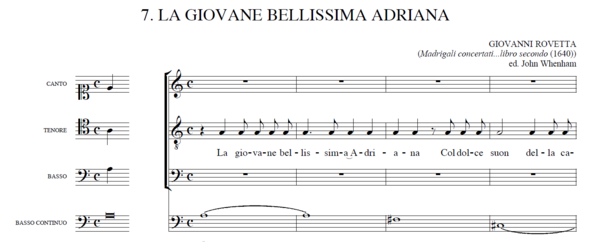
Website: ASCIMA Website: ASCIMA
The ASCIMA website, directed by John Whenham at Birmingham University (UK), provides full critical editions of entire volumes of secular vocal music which has been edited from printed part-books. Current holdings include madrigal collections by Tarquinio Merula, Claudio Monteverdi, Martino Pesenti, Giovanni Rovetta, Barbara Strozzi, and Giuseppe Valentini. Both single works and entire opuses can be downloaded as single files. Sound files are provided for each work.
C.P.E. Bach: The Complete Works
Website: C.P.E. Bach: The Complete Works
This digital analogue of the printed set allows users to download complete scores. Critical notes are viewable online. All scores can be downloaded as PDFs by going to the "Contents of Series and Volumes" tab and selecting the work. Users seeking a work by catalogue number can consult the "Search" tab. Non-transferable performing parts can be ordered at the Performing Materials tab without cost on request. This series, which now includes links to facsimiles, the composer's autobiography, a catalog of his Nachlass, and a scan of Alfred Wotquenne's thematic catalog, is nearing completion.
Du Fay: Opera Omnia
Website: Du Fay: Opera Omnia
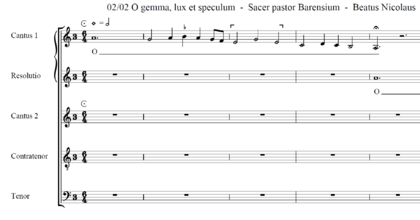
Alejandro Planchart's critical edition of all the works of Guillaume Du Fay is subdivided into eleven sections by musical/liturgical genre. The first three sections are currently available at the above link. All works are available in PDFs containing the edited music.
Gesualdo Online
Website: Gesualdo Online
Gesualdo Online is a collaborative project designed to enable dynamic editing of the of the composer's works, which are noted for their intensely chromatic development. The project is based at the University of Tours. The organizers intend to show the editorial history of individual works by managing variants with MEI (the Music Encoding Initiative) and similar protocols. As of April 2021, 222 works were available.
MARGOT
Website: MARGOT
MARGOT is focused on a range of interdisciplinary, intertextual, and intermedia projects including German adaptations of French chanson de geste, the Roman de la rose in text and image, and women writers in the ancien régime. Apart from being the home of the new CANTUS search engine (see DRM, 4.1.2), MARGOT is peripheral to most music study but complementary to certain musical topics of the medieval and early modern periods. The site is being developed at the University of Waterloo in both French and English versions.
Measuring Polyphony
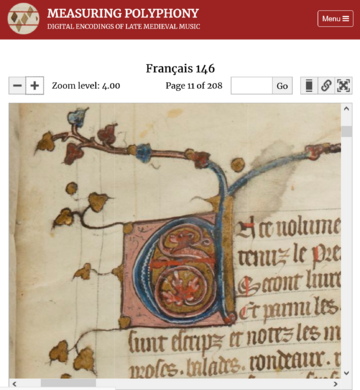
Website: Measuring Polyphony
Measuring Polyphony presents digitizations of polyphonic compositions written during the thirteenth and fourteenth centuries in mensural notation. In most cases these are linked to high-resolution images of the original manuscript sources. It offers new possibilities for mediating the scholarly and public experience of this music within its original context. It leverages the potential of the digital image repositories of music manuscripts and the community-based standards for encoding music notation of the Music Encoding Initiative (MEI). Two MEI encodings are provided--one for individual parts and one for a score. The work can also be viewed in modern notation, downloaded as a PDF, and played as a MIDI file. The use of the interoperable image framework IIIF facilitates the view of small details of the sources with many applications.
Measuring Polyphony has three goals:
- It makes transcriptions and audio freely available online to performers, scholars, and the general public, presented alongside images of the original music manuscripts;
- It encodes the medieval notation in a standardized machine-readable format so that the music data can potentially be be searched or analyzed using current tools, and through this interoperability make the data available to other websites and applications; and
- It makes the processes and tools for digitally encoding mensural polyphony in mensural notation freely available so that other stakeholders can easily and rapidly enlarge the dataset.
Under the direction of Karen Desmond, this project began at the Schulich School of Music, McGill University, and now continues at Brandeis University.
MODE: The Marenzio Online Digital Edition
Website: The Marenzio Online Digital Edition (MODE)
This online digital edition of Luca Marenzio's secular music has been under development for several years. Mauro Calcagno and Laurent Pugin are the principal investigators. The musical sources are sixteenth-century partbooks that have been scanned (and "recognized') by Pugin's Aruspix software. Scores are assembled from the recognized parts. Demonstration works allow highlighting of textual variants, alternation between original and modern clefs, and navigation from section to section via text incipits. Metadata and textual rhythm patterns can be viewed in a separate window.
Neuma
Website: Neuma
NEUMA is a digital library of music scores encoded in MusicXML and MEI. Its objectives are to provide online access to rare corpora and to demonstrate, with interactive search and analytic tools, how music notation can support advanced functionalities in the exploraton of digital scores.
Parzival (Digital Critical Edition)
Website: Parzival (Digital Critical Edition)
Owing to its long textual tradition (1210-1833) Wolfram von Eschenbach's medieval romance of the Arthurian knight Parzival and his search for the Holy Grail has an exceptionally complex history. Its sources include 16 intact manuscripts, 77 fragments, and a print from 1477. The narrative weaves together fragments of several textual traditions. The value of a new digital edition incorporating principal sources will enable the study of intertextual relationships to other epics circulated in manuscript. Elements of the new project include the creation of a catalog of manuscripts and verse-by-verse annotations. Richard Wagner read a version of the work in 1845 and began to think about composing an opera on the subject in 1857, but his opera Parsifal did not have its premiere until 1882.
Web Library of Seventeenth-Century Music (WLSCM)

Website: Web Library of Seventeenth-Century Music (WLSCM)
The Web Library of Seventeenth-Century Music (ISSN 2330-2429), which operates under the auspices of the Society for Seventeenth-Century Music, is a curated collection of music that is otherwise unavailable. Most items in its catalog feature a "full volume" of works with an introduction and critical notes. Most publications come from French and Italian composers, with numerous Spanish items recently added (2021). Current holdings include cantatas (including Lucrezia Romana, Alessandro Scarlatti), canzonas (multiple composers), keyboard works and arrangements (R. Ayleward, 67 short pieces, with audio samples; J.-B. Lully, 250 pieces newly edited from scattered manuscripts), Lament for the Queen of England (A. Bertali), madrigals (Biagio Marini), motets (M.-A. Charpentier), and spiritual monodies (G. G. Kapsberger). Collectively these downloadable editions constitute the series Monuments of Seventeenteenth-Century Music.
Editable/Searchable Score Data
CMME (Computerized Mensural Music Editing)
Website: CMME
The idea of CMME, conceived in 1999 as a Princeton undergraduate project by Ted Dumitrescu, was to support dynamic editions based on encoding standards comparable with the most rigorous printed editions. Editions of music in mensural notation have given rise to many changes of editorial opinion. In contrast to print, virtual editions have the possibility of being easily re-rendered to express changing views. On-screen views support the presence or absence of musica ficta and text underlay rationalized to fit the music or clustered at the start of line (as in many period manuscripts). Marnix van Berchem is the current director of the Utrecht-based project.
Digital Scores of Chopin's First Editions
Website: Digital Scores of Chopin's First Editions
The recent new edition of all of Chopin's works is available under the auspices of the Frideric Chopin Institute in Warsaw. Filters allow users to sort works by genre and publisher, find them by opus number, and search the musical content for specific intervalic and rhythmic patterns. Interfaces are available in Polish and English (chopinscores.org/en).
KernScores
Website: KernScores
KernScores is a comprehensive website of musical data for analysis. (Kern is the Common Western Notation encoding format the Humdrum ToolKit, which has its own website and data repository at Ohio State University.) KernScores emphasize piano music. A large number of analytical conversions can be run on-the-fly from the long list of links that follows each title listing. Most repertories are for keyboard. The full collection can be browsed here. (EsAC data has also been translated to the Kern format, and 1000 additional pieces have been added by Damien Sagrillo.) An online Humdrum editor enables users to add their own data and run simple analysis routines on it.
The following conversions of data to sound and notation are among those supported:
- MIDI (sound)
- MuseData (notation, editing, analysis)
- MusicXML (data interchange)
- ABC+ (notation)
- Guido (online notation)
KernScores also generates piano rolls, keyscapes, and several other kinds of analytical data.
MuseData
Website: MuseData
MuseData, based at the Center for Computer Assisted Research in the Humanities at Stanford University, refers to (1) an encoding system for music, (2) the software optimized for it, and (3) several corpora of scores encoded in the system. The representation system and software have been developed with Walter Hewlett from 1984 through the present. The basic features of the system are described in Beyond MIDI: .
The musical corpora contain more than 1,200 fully encoded works, including symphonies, string quartets, operas, oratorios, cantatas, and other kinds of works. The names of encoders and musical sources are embedded in the files together with other metadata. A large number of works have been encoded by Frances Bennion and Edmund Correia Jr. Other contributions have been made by Don Anthony, Jean-Pierre Dautrecourt, Pamela Decker, Michael Flexer, and Steven C. Rasmussen. The web interface and data conversion are principally the work of Craig Sapp (also the site manager), with contributions by David Huron and Andreas Kornstaedt.
Mensural extensions by Hewlett have been adopted by the Josquin Research Project and the Tasso Music project (online in 2016). MuseData supports conversion to MIDI, Humdrum Kern, SCORE, MusicXML, and MEI. Direct conversion from MuseData code to PDF is under development.
The following series of wikis provides PDF scores and/or performing parts generated from edited MuseData-encoded repositories. Finalized files are stored on github. Versions for editing can be downloaded from musedata.org.
MuseData: Ludwig van Beethoven
Website: Ludwig van Beethoven
Versions for editing can be downloaded from musedata.org.
MuseData: Arcangelo Corelli
Website: Arcangelo Corelli
The 72 sonatas and concertos published in Corelli's lifetime, with facsimiles, PDFs, MIDI files, and commentary.
Versions for editing can be downloaded from musedata.org.
MuseData: Georg Frideric Händel
Website: Georg Frideric Händel
Several of the newly edited works are protected by copyright. Shorter works (e.g. the Concerti Op. 6) may be downloaded from musedata.org and re-edited.
MuseData: Antonio Vivaldi

Website: Antonio Vivaldi
The digital Vivaldi repository currently includes complete editions based on early prints of the sonatas Opp. 1, 2, and 5; the concertos for violin(s) and string orchestra Opp. 4, 8, and 11, plus the "military" oratorio Juditha triumphans . Performing parts for Opp. 3, 8, 10, and Juditha triumphans are also available.
Josquin Research Project
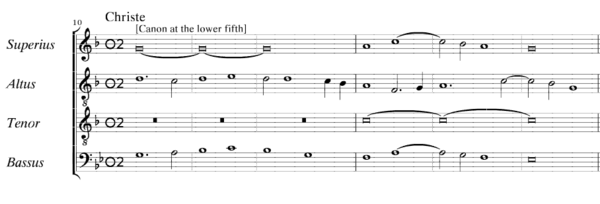
Website: Josquin Research Project
The Josquin Research Project began as an effort to support comparative evaluations of authorship. Surviving works attributed to Josquin fall into two broad groups: those for which authorship is secure and those for which attributions to multiple composers may exist. Currently, 763 works by a total of 23 composers are included. Motets and mass sections predominate. The number of voices varies from three to six. Users can search for pitches, intervals, and rhythmic patterns in a browser. The files are available in several symbolic formats (MIDI, Humdrum, MEI, MuseData, MusicXML, MP3, and PDF). Displays with and without musica ficta are supported. Jesse Rodin is the principal investigator. Craig Sapp manages the website and tool implementations.
Tasso in Music Project
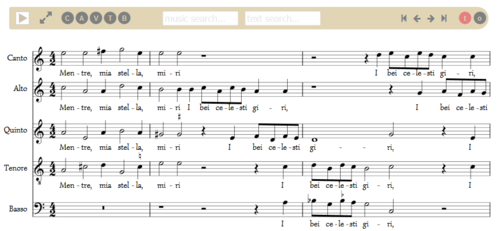
Website: Tasso in Music Project
The Tasso in Music Project, under the direction of Emiliano Ricciardi, presents all the musical settings of the poetry of Torquato Tasso (1544-1595). For the time, Tasso's work was widely distributed. It was accessible to both the learned and to ordinary people. His best known works are Aminta (1573) and Gerusalemme liberata (Jerusalem liberated, 1574), an epic focused on the First Crusade. Its numerous tales were retold in countless musical contexts, including Monteverdi's Tancredi e Clorinda and subsequent operas of the seventeenth century. Tasso's biography, which incorporated notable emotional vicissitudes, inspired later works by Liszt and Donizetti. Tasso's Rime (Rhymes) were set prolifically by Gesualdo(1566-1613) and Wert (1535-1596). The Tasso project makes both the literary texts and the music (including multiple settings of the the same text) available. The integration of critical information (sources, variants, clefs, mensuration signs) and tools for extracting text from the music are provided. Technical direction is provided by Craig Sapp. Numerous scholars contribute their expertise to the project. Alternative formats follow the model of the Josquin Research Project.
Turkish Makam Music Collection
Website: Turkish Makam Music Collection (SymbTr)
The Turkish Makam Music Symbolic Data Collection (SymbTr) is designed for analysis of encoded repertories and is currently the largest repertory of its kind. It offers 2,200 pieces from 155 makams, 88 usuls, 56 forms, about 865,000 musical notes (80 hours of nominal playback time). Makam is a system of intervalic relationships and melodic development types widely used in Turkish, Persian, and Arabic music. This set of encoded scores, based on pieces from Turkish art and folk music, is based on authoritative sources. It covers a broad historical time span among pieces which are still performed in today. Scores are available in text, MusicXML (compatible with MuseScore, Finale and Sibelius), PDF, MIDI and mu2 formats. The mu2 format is readable by the microtonal notation editor Mus2. Now available from github.
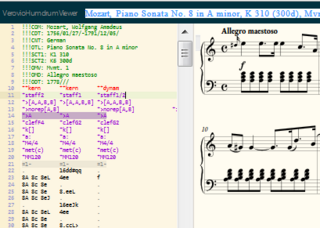
Verovio Humdrum Viewer (and Editor)
Website: Verovio Humdrum Viewer
The Verovio Humdrum Viewer (VHV) is an implementation of Verovio based on the Kern data format used by the Humdrum (Musical Analysis) Toolkit. While viewing a score produced from encoded material, a user can edit the code and see the changes immediately. By clicking an arbitrary point in the displayed score the music can also be heard. Verovio is a lightweight library for engraving MEI (Music Encoding Initiatve) scores into vector graphics for online display.)
Hybrid Digital Editions
The term "hybrid critical editions" refers to means of producing series of critical editions (usually all the works of one composer) in which the score is published in book form while the critical apparatus consists of digitized sources which are hyperlinked to one another to facilitate comparison. Underlying materials may also be linked to metadata (factual content) in a database or other structured, searchable format. The primary software tool currently in use for preparing such editions is called the Edirom. It is developed and maintained by the Detmold/Paderborn musicology seminar, which offers an annual summer school for prospective users.
Anton Bruckner Collected Edition
Website: Anton Bruckner Gesamtausgabe
The new edition currently in progress is part of a comprehensive Bruckner site, at the Bruckner internet portal of the Austrian National Library in Vienna. A work search form can be found here, a database of works here, and digitized copies of out-of-copyright works here.
Carl Maria von Weber Collected Edition
Website: Carl Maria von Weber Gesamtausgabe
The Carl Maria von Weber Collected Edition has been the proving ground for the Edirom, an MEI-based tool for viewing collateral sources and cross-linking details to corresponding points in a printed score. The edition website gives access to biographical and philological adjuncts--letters, diaries, work listings, and so forth. The digital apparatus to support the score editions (i.e. the Edirom) is described here. The Music-Encoding Initiative (MEI) has an extensive website here.
Freischütz Digital
Website: Freischütz Digital
A proof-of-concept project complementing the Carl Maria von Weber hybrid digital edition. It involves a database, musical transcriptions, and (like other hybrid editions) material encoded in TEI and MEI. In addition contributions from allied technologies are being considered.
Return to Digital Resources in Musicology
Score Aggregations
Choral Public Domain Archive (CPDL)
Website: Choral Public Domain Archive
The Choral Public Domain Archive, a collaborative website for choral-music directors, was founded by Rafael Ornes in 1995 and maintained by him for more than a decade. More than 3,000 scores were included in the linked database. The collection was later aggregated with other online scores and converted to a wiki, thererby increasingly the total number of holding substantially and diffusing the management. Many holdings are extracts from longer works found in their entirety at the MuseData, Werner Icking, and other respositories. CPDL is a useful source for arrangements of short pieces, most of them choral but some purely vocal. Holdings include capella, Finale, Lilypond, MuseScore, MIDI, Noteworthy Composer, PDF, PostScript, and Sibelius files. Music by roughly 2,600 composers can be found here. A useful feature in CPDL is the presence of full texts of lyrics. Contributions come from all over the world. Copyright restrictions are clearly indicated.
International Music Score Library Project (IMSLP)
Website: International Music Score Library Project (IMSLP)

When Ottaviano Petrucci, a Venetian typesetter, set in motion the printing of polyphonic music in his xx (1501) he could not possibly have imagined that its namesake virtual library, the Petrucci Music Library, would today boast almost 100,000 items. Besides 330,000 scores (as of October 2015), 98,000 "works" (including numerous titles of early music-theory treatises and performance manuals), and 37,000 recordings, IMSLP (colloquially pronounced Im'-slip) is a cornucopia of miscellaneous information about composers (13,300 of them) and their available works.
The nature of contributions is diverse in quality and in photographic quality. Because IMSLP attempts to serve a global audience, it has frequently foundered on the shoals of copyright differences from country to country and has occasional run afoul of library and publishers' conventions. Among materials digitized by libraries (and re-served here) the original site is often preferable for professionals because it provides full particulars of sources, extensive metadata, contextual information about collections holding the desired item, and advice about rights and permissions. (We hope DRM makes it easy to find the original post of digitized scores.)
Edward W. Guo, the Canadian founder and head of IMSLP, was a composition student at the New England Conservatory of Music in Boston when he started the site (2006). (Guo is also a violinist and pianist.) The perplexities of adjudicating rights and permissions issues led him to pursue a law degree (Harvard, 2012). Two hundred volunteers help to develop the site.
Return to EVE
Return to Digital Resources in Musicology
Score Visualizations
KeyScapes
Craig Sapp's KeyScapes are visualizations of harmonic structure. Sapp began to develop them as a graduate student at the Center for Computer Research in Music and Acoustics at Stanford University in the late 1990s. Although keyscapes are useful in giving a synoptic view of the harmonic structure of single movements and/or works, their use in the aggregate indicates many changes over time.
The initial Tonal Landscape Gallery gives a brief visual introduction. Here, for example, is a table of keyscapes representing each movement of the 32 Beethoven piano sonatas. Tonal architectures between movements of single works and changes in this relationship are particularly visible.
For large-scale comparison functional (relative) harmony (divorced from a specific key) proves more useful than exact-pitch (absolute) mapping, as this representation of the same Beethoven sonatas shows.
Every piece at Sapp's KernScores website provides a virtual keyscape that may be absolute or relative. In movements with repeats, the user may select a view with or without repeats included. Sapp's doctoral thesis (2011) show extensive comparisons. In other writings he has used the same technique to discover biases in multiple approaches to harmonic analysis used today.
Music Animation Machine
Stephen Malinowski's Music Animation Machine (MAM) is well-known in computer-music circles but is underutilized in classrooms, where its value transcends diverse levels of education and musical training. Originating in California in 1985 and continuously improved ever since, it works like a video-camera for the inner workings of music fabric. It presents a wide range of geometrical objects moving across the viewer's screen. Depend on its settings it can emphasize relationships between pitches, harmonies, rhythmic values, loudness, and so forth. Viewers will find rhythmic patterns and contrapuntal refinements of the music being viewed hard to miss. Although MAM was originally dependent on MIDI, it has been retooled to work in live concert settings. Malinowski's Youtube channel (smalin) offers the best current (graphical) lexicon of its offerings, but other MAM websites include the history of its gestation and development, freeware (Windows only), sample files (ibid), works listed by [collaborator http://www.musanim.com/Collaborators/] and miscellaneous items. MAM also has listings by collection and composer, e.g. The Well-Tempered Clavier.
An ongoing catalog of animated graphical scores is available at Music Worth Watching. Over time the methods of varieties of visualization have increased to better accommodate the wide array of moods that will be "seen" from piece to piece.
For more information on the graphical methods used, see Music Animation Screen Renderers.
Ptolemaic: Musical Visualization and Analysis
Website: Ptolemaic: A computer application for musical visualization and analysis
This set of software tools displays dynamic renderings of music in relation to several concepts from music-theory: pitch class, tonal pitch-space, and functional harmonic analysis. Tools are freely downloadable.
TimeScapes
Craig Sapp's TimeScapes facilitate rapid comparison of differences in timing in recorded performances. They have played a major role in his work with the CHARM Mazurka Project directed by Nicholas Cook (2005-07). Companion software tools are available through the Sonic Visualizer website. The TimeScape concept is derived from Sapp's earlier work on KeyScapes (see above).